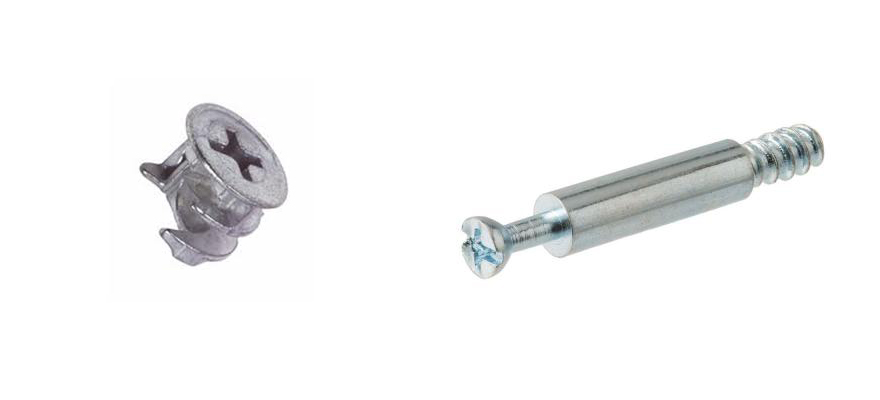Death to Cam Lock Nuts: Flatpack Hardware That Will Hopefully Become Obsolete

If you've ever assembled a piece of IKEA furniture, you've undoubtedly seen the two items up above, and you understand how they fit together:

For the average consumer that doesn't know what they're called, they're named cam lock nuts and cam screws. You'll hear them referred to colloquially as "knock-down fasteners" (and occasionally "Confirmat fasteners," which I believe is incorrect; if enough of you are interested in why, let me know in the comments and I'll pull another entry together). They've been a mainstay of IKEA's flatpack product line for as long as I can remember, although from a design perspective, it seems clear that their benefits are outweighed by their drawbacks.
The meager benefits of cam lock nuts and screws is that they can be driven with a Philips screwdriver, which most consumers have rattling around in a drawer somewhere, and they provide a relatively quick connection method that's low on labor. And on the manufacturing side, they can be used with butt joints, which is by far the simplest and least expensive thing to cut on a production line.
The drawbacks are far greater. The key flaw is that they're designed to be used with particle board, which does not take fasteners well. Because of this it's easy to drive the screw in at a slight angle. The screw is then forced straight when the end user inserts it into the cam lock nut, and this further weakens the point of connection between the screw threads and the mushy particle board fibers. The resultant connection will not withstand shearing forces well, and multiple cam lock nuts and screws are needed along a single edge to form even a barely tolerable connection. Lastly, cam lock nuts are unattractive, and IKEA designers of course take pains to put them on the insides or undersides of surfaces.
IKEA's global influence alone is enough reason for independent manufacturers to keep producing these inferior pieces of hardware. (You can find them everywhere from Amazon to eBay to Home Depot from a variety of manufacturers.) Thankfully though, the designers at IKEA's HQ have been working on a new connection method with several advantages over cam lock nuts. Check it out.
-
o1Favorite This
-
Q12Comment
K
{Welcome
Create a Core77 Account
Already have an account? Sign In
By creating a Core77 account you confirm that you accept the Terms of Use
K
Reset Password
Please enter your email and we will send an email to reset your password.


Comments
How long do I need to stay tuned for? What's the new connection method?
I loathe these things. I've been putting IKEA furniture together for many years and was just working on some pieces yesterday - their HAVSTA bookcases are really quite nice-looking and made of moderately heavy pine boards, so I like them. But I loathe these things. In my experience, about 1/3rd of them turn nicely and rotate 180" into position like they are supposed to. The rest have lots of problems. Often the hole for the cam is not deep enough, or something isn't quite straight with the screw, or it doesn't extend quite far enough into the hole for the cam. The result is that I can't turn the thing all the way around. I am only using hand tools since I have learned the hard way not to use powered screw drivers to turn these things. I've torn the prongs right off even trying to tighten them with a screwdriver. It seems like the cams are made of a poor grade of metal. Even with a properly-fitting screwdriver, sometimes the screwdriver socket will break, leaving bits of broken metal..
Fortunately they seem to hold well enough even if they don't quite work right, but they are unpleasant to work with and I would dearly love to see an alternative method in future versions of these furniture pieces.
Hey Rain, did you ever do that "Stay tuned" follow-up on this article and please can you direct me...? Many thanks.
For the time being we need a solution to keeping the Cam screw perpendicular while it is being tightened. It is so frustrating, especially if you want to use a cordless drill. My suggestion is to design a very simply universal jig which holds the screw vertical long enough to get it started. Even a simple clothes peg could help?
I think I have a solution for you. We just ran into this issue at my day job, so I designed and 3D printed a jig that worked great. It you're interested let me know.
Hey Kevin, I need to know can you tell me about it
Akansh Dubey I can't seem to reply to your comment. However the jigs are available for purchase here: https://www.etsy.com/listing/709530405/cam-and-dowel-jig
Hey Rain Noe. I am grateful for this review on the cam and lock nuts. I would like you to consult with me on a furniture design project...RTA/KD. Reach me via mail on urladycarpenter@gmail.com
Check out Lockdowel's new Eclips products for fastening furniture. Home video shows cabinet panels going together in minutes. No cam locks, screws , glue or tools needed. The boards slide together to make a strong and invisible joint. .... https://www.youtube.com/watch?v=g43HOrOHoqo
If the chip board is poorly made it will break apart when you tighten the CAM nut causing it not to sit straight and this will cause the CAM nut to twist and it will break apart. You may not be able to get the part of the Cam nut that is between the clip board and the CAM bolt. I found this is a poorly made fastner to use on items that needs a strong fastner to assembly an item that will support a lot of weight.
I've been researching connection methods for my panel based product (insulated dog houses) and I happily found this article.